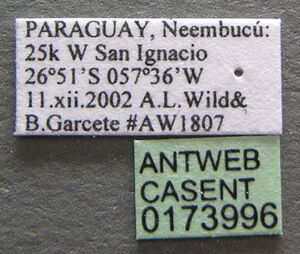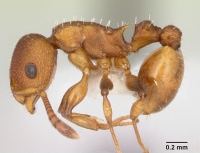Nesomyrmex spininodis
| Nesomyrmex spininodis | |
|---|---|

| |
| Scientific classification | |
| Kingdom: | Animalia |
| Phylum: | Arthropoda |
| Class: | Insecta |
| Order: | Hymenoptera |
| Family: | Formicidae |
| Subfamily: | Myrmicinae |
| Tribe: | Crematogastrini |
| Genus: | Nesomyrmex |
| Species: | N. spininodis |
| Binomial name | |
| Nesomyrmex spininodis (Mayr, 1887) | |
| Synonyms | |
| |
Schmid et al. (2014) found this ant nesting in infructescences (the stem and remains of buds and fruits above the level of the water reservoir in the rosette) of the bromeliad Vriesea friburgensis on Santa Catarina Island, Brazil. Arredondo & Guerrero (2025) report collecting it by manual sampling on vegetation in Parque Nacional Natural Tuparro, Colombia.
Photo Gallery
Identification
Arredondo & Guerrero (2025) -This species can be recognized by:
- 11 antennomeres
- uniformly testaceous or yellowish-brown coloration
- dorsal surface of head finely reticulate-punctate and longitudinally rugose, without presence of shiny areas
- basal third of first gastral tergite generally aciculate-striate in its sculpture
Kempf (1959) synonymized all previously described species and subspecies within the echinatinodis complex under the nominal species, except for N. spininodis. A potential revision of the N. echinatinodis complex could either result in the synonymization of certain species or the division of the complex into multiple forms. It is common to find Nesomyrmex echinatinodis exhibiting sculpture similar to that of N. spininodis, particularly in populations from Colombia different from those living in the TDF (Unpublished data). Additionally, coloration is highly variable within the echinatinodis complex. For this reason, using coloration as the primary criterion for distinguishing between different forms is not recommended. Thus, the separation of both species should not rely solely on coloration; instead, the sculpture of the frontal area of the head and the first gastral tergum should also be compared.
Keys including this Species
Distribution
Latitudinal Distribution Pattern
Latitudinal Range: -0.631944444° to -34.583333°.
| North Temperate |
North Subtropical |
Tropical | South Subtropical |
South Temperate |
- Source: AntMaps
Distribution based on Regional Taxon Lists
Neotropical Region: Argentina, Bolivia, Brazil (type locality), Colombia, Ecuador, French Guiana, Guyana, Paraguay, Suriname, Trinidad and Tobago, Venezuela.
Distribution based on AntMaps
Distribution based on AntWeb specimens
Check data from AntWeb
Countries Occupied
| Number of countries occupied by this species based on AntWiki Regional Taxon Lists. In general, fewer countries occupied indicates a narrower range, while more countries indicates a more widespread species. |

|
Estimated Abundance
| Relative abundance based on number of AntMaps records per species (this species within the purple bar). Fewer records (to the left) indicates a less abundant/encountered species while more records (to the right) indicates more abundant/encountered species. |

|
Biology
Koch et al. (2018) sampled this species in Caryocar barsiliense trees, in southeastern Brazil cerrado, as part of a study examining species interactions in ant-plants.
Castes
Queen
Images from AntWeb
   
| |
| Queen (alate/dealate). Specimen code casent0173996. Photographer April Nobile, uploaded by California Academy of Sciences. | Owned by ALWC, Alex L. Wild Collection. |
Nomenclature
The following information is derived from Barry Bolton's Online Catalogue of the Ants of the World.
- spininodis. Leptothorax spininodis Mayr, 1887: 617 (w.m.) BRAZIL. Forel, 1912g: 18 (q.). Combination in L. (Goniothorax): Emery, 1896g: 59 (in key); in L. (Nesomyrmex): Kempf, 1959c: 427; in Nesomyrmex: Bolton, 2003: 272. Subspecies of echinatinodis: Forel, 1899c: 55; Emery, 1924d: 250. Revived status as species and senior synonym of genualia, umbratilis: Kempf, 1959c: 427.
- umbratilis. Leptothorax (Goniothorax) umbratilis Wheeler, W.M. 1921f: 160 (w.q.) GUYANA. Junior synonym of spininodis: Kempf, 1959c: 427.
- genualia. Leptothorax (Goniothorax) genualia Santschi, 1922d: 252 (w.) PARAGUAY. Junior synonym of spininodis: Kempf, 1959c: 427.
Description
References
- Albuquerque, E., Prado, L., Andrade-Silva, J., Siqueira, E., Sampaio, K., Alves, D., Brandão, C., Andrade, P., Feitosa, R., Koch, E., Delabie, J., Fernandes, I., Baccaro, F., Souza, J., Almeida, R., Silva, R. 2021. Ants of the State of Pará, Brazil: a historical and comprehensive dataset of a key biodiversity hotspot in the Amazon Basin. Zootaxa 5001, 1–83 (doi:10.11646/zootaxa.5001.1.1).
- Arredondo, B.S., Guerrero, R.J. 2025. The ant genus Nesomyrmex Wheeler (Formicidae, Myrmicinae) from the threatened Colombian tropical dry forest: three new species, a new synonymy, and new distributional data. ZooKeys 1232, 131–172 (doi:10.3897/zookeys.1232.141693).
- Bolton, B. 2003. Synopsis and Classification of Formicidae. Mem. Am. Entomol. Inst. 71: 370pp (page 272, Combination in Nesomyrmex)
- Emery, C. 1896g. Studi sulle formiche della fauna neotropica. XVII-XXV. Bull. Soc. Entomol. Ital. 28: 33-107 (page 59, Combination in L. (Goniothorax) (in key))
- Emery, C. 1924f [1922]. Hymenoptera. Fam. Formicidae. Subfam. Myrmicinae. [concl.]. Genera Insectorum 174C: 207-397 (page 250, Race/subspecies of echinatinodis)
- Forel, A. 1899d. Formicidae. [part]. Biol. Cent.-Am. Hym. 3: 25-56 (page 55, Race/subspecies of echinatinodis)
- Forel, A. 1912h. Formicides néotropiques. Part IV. 3me sous-famille Myrmicinae Lep. (suite). Mém. Soc. Entomol. Belg. 20: 1-32 (page 18, queen described)
- Franco, W., Ladino, N., Delabie, J.H.C., Dejean, A., Orivel, J., Fichaux, M., Groc, S., Leponce, M., Feitosa, R.M. 2019. First checklist of the ants (Hymenoptera: Formicidae) of French Guiana. Zootaxa 4674, 509–543 (doi:10.11646/zootaxa.4674.5.2).
- Kempf, W. W. 1959d. A synopsis of the New World species belonging to the Nesomyrmex-group of the ant genus Leptothorax Mayr (Hymenoptera: Formicidae). Stud. Entomol. (n.s.) 2: 391-432 (page 427, Combination in L. (Nesomyrmex), Revived status as species, and senior synonym of genualia and umbratilis)
- Koch, E. B. A., W. Dattilo, F. Camarota, and H. L. Vasconcelos. 2018. From species to individuals: does the variation in ant-plant networks scale result in structural and functional changes? Population Ecology. 60:309-318. doi:10.1007/s10144-018-0634-5
- Ladino, N., Feitosa, R.M. 2022. Ants (Hymenoptera: Formicidae) of the Parque Estadual São Camilo, an isolated Atlantic Forest remnant in western Paraná, Brazil. ZOOLOGIA 39: e22001 (doi:10.1590/S1984-4689.v39.e22001).
- Mayr, G. 1887. Südamerikanische Formiciden. Verh. K-K. Zool.-Bot. Ges. Wien 37: 511-632 (page 617, worker, male described)
References based on Global Ant Biodiversity Informatics
- Calcaterra L. A., F. Cuezzo, S. M. Cabrera, and J. A. Briano. 2010. Ground ant diversity (Hymenoptera: Formicidae) in the Ibera nature reserve, the largest wetland of Argentina. Ann. Entomol. Soc. Am. 103(1): 71-83.
- Cuezzo, F. 1998. Formicidae. Chapter 42 in Morrone J.J., and S. Coscaron (dirs) Biodiversidad de artropodos argentinos: una perspectiva biotaxonomica Ediciones Sur, La Plata. Pages 452-462.
- Emery C. 1896. Formiciden, gesammelt in Paraguay von Dr. J. Bohls. Zoologische Jahrbücher. Abteilung für Systematik, Geographie und Biologie der Tiere 9: 625-638.
- Fernández, F. and S. Sendoya. 2004. Lista de las hormigas neotropicales. Biota Colombiana Volume 5, Number 1.
- Forel A. 1908. Catálogo systemático da collecção de formigas do Ceará. Boletim do Museu Rocha 1(1): 62-69.
- Forel A. 1912. Formicides néotropiques. Part IV. 3me sous-famille Myrmicinae Lep. (suite). Mémoires de la Société Entomologique de Belgique. 20: 1-32.
- Franco W., N. Ladino, J. H. C. Delabie, A. Dejean, J. Orivel, M. Fichaux, S. Groc, M. Leponce, and R. M. Feitosa. 2019. First checklist of the ants (Hymenoptera: Formicidae) of French Guiana. Zootaxa 4674(5): 509-543.
- Gomez V. E. S., and G. Z. González. 2007. Catalogo de Las Hormigas Presentes en El Museo de Historia Natural de la Universidad del Cauca. Popayán : 1-58.
- Kempf W. W. 1959. A synopsis of the New World species belonging to the Nesomyrmex-group of the ant genus Leptothorax Mayr (Hymenoptera: Formicidae). Studia Entomologica (n.s.)2: 391-432.
- Kempf W. W. 1978. A preliminary zoogeographical analysis of a regional ant fauna in Latin America. 114. Studia Entomologica 20: 43-62.
- Kempf, W.W. 1972. Catalago abreviado das formigas da regiao Neotropical (Hym. Formicidae) Studia Entomologica 15(1-4).
- Kusnezov N. 1978. Hormigas argentinas: clave para su identificación. Miscelánea. Instituto Miguel Lillo 61:1-147 + 28 pl.
- Marinho C. G. S., R. Zanetti, J. H. C. Delabie, M. N. Schlindwein, and L. de S. Ramos. 2002. Ant (Hymenoptera: Formicidae) Diversity in Eucalyptus (Myrtaceae) Plantations and Cerrado Litter in Minas Gerais, Brazil. Neotropical Entomology 31(2): 187-195.
- Pires de Prado L., R. M. Feitosa, S. Pinzon Triana, J. A. Munoz Gutierrez, G. X. Rousseau, R. Alves Silva, G. M. Siqueira, C. L. Caldas dos Santos, F. Veras Silva, T. Sanches Ranzani da Silva, A. Casadei-Ferreira, R. Rosa da Silva, and J. Andrade-Silva. 2019. An overview of the ant fauna (Hymenoptera: Formicidae) of the state of Maranhao, Brazil. Pap. Avulsos Zool. 59: e20195938.
- Ryder Wilkie K.T., A. L. Mertl, and J. F. A. Traniello. 2010. Species Diversity and Distribution Patterns of the Ants of Amazonian Ecuador. PLoS ONE 5(10): e13146.doi:10.1371/journal.pone.0013146
- Santschi F. 1931. Contribution à l'étude des fourmis de l'Argentine. Anales de la Sociedad Cientifica Argentina. 112: 273-282.
- Santschi F. 1933. Fourmis de la République Argentine en particulier du territoire de Misiones. Anales de la Sociedad Cientifica Argentina. 116: 105-124.
- Schmid V. S., S. Langner, J. Steiner, and A. Zillikens. 2014. Inflorescences of the Bromeliad Vriesea friburgensis as Nest Sites and Food Resources for Ants and Other Arthropods in Brazil. Psyche http://dx.doi.org/10.1155/2014/396095
- Siqueira de Castro F., A. B. Gontijo, P. de Tarso Amorim Castro, and S. Pontes Ribeiro. 2012. Annual and Seasonal Changes in the Structure of Litter-Dwelling Ant Assemblages (Hymenoptera: Formicidae) in Atlantic Semideciduous Forests. Psyche doi:10.1155/2012/959715
- Siqueira de Castro F., A. B. Gontijo, W. Duarte da Rocha, and S. Pontes Ribeiro. 2011. As comunidades de formigas de serapilheira nas florestas semidecíduas do Parque Estadual do Rio Doce, Minas Gerais. MG.BIOTA, Belo Horizonte 3(5): 5-24.
- Vittar, F. 2008. Hormigas (Hymenoptera: Formicidae) de la Mesopotamia Argentina. INSUGEO Miscelania 17(2):447-466
- Wheeler W. M. 1921. The Tachigalia ants. Zoologica (New York) 3: 137-168.
- Wheeler W. M. 1942. Studies of Neotropical ant-plants and their ants. Bulletin of the Museum of Comparative Zoology 90: 1-262.
- Wilson E. O. 1962. Behavior of Daceton armigerum (Latreille), with a classification of self-grooming movements in ants. Bulletin of the Museum of Comparative Zoology 127: 403-421.
- do Nascimento, I.C. 2006. Fenologia dos Voos de Acasalamento em Formigas Tropicais



